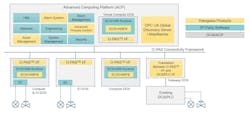Yokogawa introduced the distributed control system (DCS) to the world 50 years ago, and continues its history of innovation with its most recent Open Process Automation (OPA) product line release and project implementation. Even as traditional DCS platforms continue to evolve, progress with open standards offers new opportunities.
Using its skills as the systems integrator (SI) for ExxonMobil’s Lighthouse Project, Yokogawa implemented its Open Automation SI Kit with third-party hardware, third-party control software and other non-Yokogawa software applications to prove the OPA concepts defined by the Open Process Automation Standard (O-PAS).
The system included implementation of OPA’s secure-by-design concepts, and secure onboarding of the devices. The recent article, “Plug-and-play punches in” describes how the project uses O-PAS’ plug-and-play capabilities to integrate SI kit software with hardware components from various vendors. The resulting automation system controls about 100 loops and 1,000 I/O (Figure 1).
Per the article, “The system was fully powered up and finished hot cutover on Nov. 8, 2024. A cold cutover was completed on Nov. 17, 2024, and the commercialized, OPA-guided application began making product and generating revenue for ExxonMobil the next day.”
The Lighthouse project implemented Version 2.1 of O-PAS, with the factory acceptance test (FAT) completed in August 2024. This extended FAT process, which included rigorous testing under real-world scenarios, proved the control system was safe and reliable—critical for a facility that must operate continuously without unplanned downtime.
Under the hood with OPA
OPA aims to achieve the interoperability and portability of systems by standardizing communication methods and information models. Improved security is also a key benefit because OPA takes a secure-by-design approach, with OPA components supporting the IEC 62443-4-2 security standard’s Level 2 capabilities.
OPA accelerates data use and IT/OT convergence by standardizing interfaces among all system components. Furthermore, it provides a pathway to modernize existing systems by extending the OPA system to legacy equipment through gateways. For new, grassroots projects, OPA lets customers select fit-for-purpose and best-in-class system components, accelerates automation of system configurations, and provides services that save money and time.
The O-PAS standard and the application of OPA technologies in process automation are still developing, with early projects providing great feedback to the Open Process Automation Forum (OPAF). The market, implementation and certification of products are maturing, but at this stage, it’s important to proceed carefully.
Pick your OPA partner carefully
While some automation vendors enthusiastically support and participate in OPA (controlglobal.com/OPAF-keeps-plugging), others remain on the sidelines, offering only traditional DCS solutions. We believe end users are best served by suppliers that provide options, so they can choose the path that best fits their organizational and business needs. For some end users, this means continuing to use tried-and-true DCS solutions to take advantage of the comprehensive, worldwide, supplier support commonly provided for DCS-based automation systems.
Other end users see value in a hybrid approach, choosing DCS solutions in some areas, while implementing automation systems based on OPA for other projects. OPA automation systems aim to provide much lower hardware and software costs up front and throughout system lifecycles because end users can mix and match components from many different vendors. Through extensive use of OPC UA and other open standards, connectivity to all types of components and software systems internal and external to automation systems is greatly improved with OPA.
While hardware costs are lower, multiple software and licensing options require more systems integration than is currently required for a DCS. While the goal of OPA is to have these components work together in a plug-and-play fashion, it usually takes time for this level of interoperability to reach its full potential. Some end users may decide to perform the required integration internally, while others may choose to work with an experienced SI.
To maximize the potential benefits of OPA, end users may need to learn a more IT-based approach to automation in addition to their OT skillsets. Because OPC UA communications are integral to OPA, proficiency with it is also critical. End users should be aware that some automation vendors have fully bought into OPC UA, while others are taking a more cautious approach.
Get your subscription to Control's tri-weekly newsletter.
This makes it important for end users to carefully evaluate the SIs they partner with for OPA projects because the chosen company must understand all aspects of OPA component integration. This includes the specifications, security and characteristics of each device and software solution, as well as the supervisory software systems that tie everything together. Prior experience with OPA projects is critical when selecting a partner for these open-automation systems.
Open systems will advance the journey from industrial automation to industrial autonomy (IA2IA), as will advances with more traditional DCSs.
DCS advances drive IA2IA
As described in a recent Control magazine interview (controlglobal.com/YokogawaIA2IA) and summarized here, the journey from IA2IA continues with the latest iterations of the DCS.
Specifically, the modern DCS is evolving in three main areas:
- Operability improvement with labor-saving measures, such as effective alarm management, and other advanced measures, such as ergonomic engineering;
- Connectivity improvement with expanded project execution scopes, such as added capabilities for communication among subsystems; and
- Engineering efficiency improvement, resulting in reduced engineering costs, plus more timely and cost-effective project execution.
The DCS itself is also evolving based on IA2IA concepts, with three notable milestones in this area over the past few years. First, the autonomous control AI protocol, Factorial Kernel Dynamic Policy Programming (FKDPP), was adopted for use at an ENEOS Materials Corp. chemical plant.
Second, IT/OT convergence has been realized with the introduction of our information server platform, which created an integrated operations environment that covers an entire plant or even multiple plants by connecting with ours and third-party control systems. The third milestone is using single-user-interface operation for different robots from multiple suppliers, and coordinating DCS operation with robots based on the aforementioned information server platform. We envision a future where distributed controls and robots work together.
Digital twins will also play a key role in IA2IA in three main ways. First, digital twins can supplement information that can’t be measured in the physical plant. This includes soft sensors that don’t perform physical measurements, but can predict them based on other measured or calculated parameters. Second, the ability to generate future, digital-twin information from a time-series perspective makes it possible to act in advance against a future that may occur based on extrapolating current parameters into the future. Third, the scope of the digital twin will expand from unit-level processes and asset twins to plant-wide twins, and even to twins covering entire supply chains.
The DCS is evolving with innovations to traditional platforms, and with OPA, we’ll continue to support end users on their organization's path.
About the Author

Mitsuhiro Yamamoto
Yokogawa
Mitsuhiro Yamamoto is a Yokogawa Electric’s VP and executive officer, and head of its systems business division.


